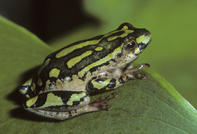Changing Environment

The problem with global warming is that when change comes, it will probably be too fast for species to adapt at a genetic level. Many high altitude frogs and toads could be at the ceiling of their possible range shift - they have no more 'up' in which to move. For the frogs living in this mossy, cold little world, things could become a lot drier and more troublesome in the next fifty years. Another threat also comes from the sky.
The depletion of atmospheric ozone in recent decades, largely through CFCs (chlorofluorocarbons), means that greater amounts of UV-B radiation reach the planet. We have already seen increases in skin cancers in people, as a result, and frogs don't have it much better. UV-B can scramble their DNA, hammering their eggs and tadpoles, generally eroding their breeding success, and spawning weird genetic offshoots.
There is some good news for fynbos frogs. The mountain waters in this area are full of nutrient humus, tinted red-brown from tannins and vegetation to look like well-stewed tea. The colour might act as a natural sunscreen, filtering UV the way that dust does in the atmosphere.
Decline in Frog Population
Globally, frog numbers have dropped radically. The spread of infectious diseases; and non-indigenous predators are causes. Locally we are changing fire regimes, particularly in fynbos and grass systems.
We are introducing alien plants into delicate ecosystems; ploughing up land for agriculture; polluting water courses with fertilizer run-off, herbicides, pesticides, petroleum products and heavy metals. We are carving up and degrading the habitats of frogs, constructing dams, driving cattle into moist grasslands, and building roads across their breeding migration routes.
The Frog Atlas singles out species in the succulent karoo and northern reaches of fynbos as those most likely to suffer in the warming and drying that will be most severe in these regions.
Should you like to acquaint yourself with the Namaqua stream frog (Strongylopus springbokensis), the Desert rain frog (Breviceps macrops), the Paradise toad (Bufo robinsoni), the Namaqua dainty frog (Cacosternum namaquense) or the Karoo dainty frog (Cacosternum karooicum), you would be well advised to do so quickly. Already they are a rarity in this arid place and their numbers will only decline as global warming dries out their home further.